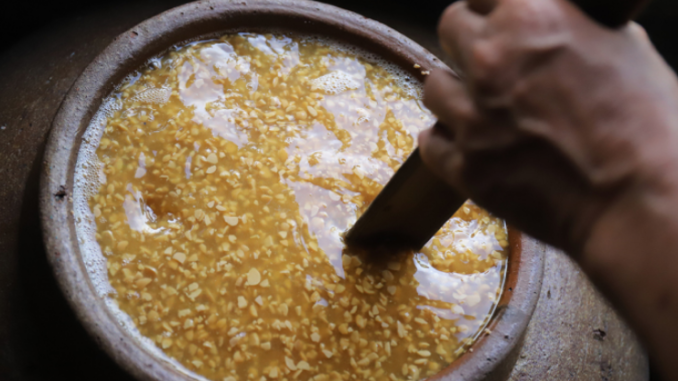
NGHE AN – Nam Dan people make soy sauce from beans grown along the Lam River. The soy sauce is thick, and dark yellow like honey or the color of cockroach wings.
On the late afternoon of September, Mr. Pham Hai Duong, 77 years old, residing in Phan Boi Chau street, Nam Dan town, walked around the outhouse, opened dozens of ceramic jars containing soy sauce, and used large bamboo chopsticks to stir well. He carefully checked whether the sauce met standards before bottling and selling to partners.
After more than 30 years of making soy sauce, Mr. Duong said this job is not too difficult, but requires diligence and carefulness.

The main ingredients to make are soybeans, sticky rice, salt, and clean water. Beans grown on the strip of land along the Lam River in Nam Dan district cost 60,000-70,000 VND per kilogram. During the season, craft villagers often buy goods to store.
The bean seeds for making soy sauce must be even and large, dried, then roasted, shelled, crushed, then put in a specialized pot to cook for 12-15 hours. When the beans cool, pour them into clay jars and soak them in clean water for about 7 days. During this time, every morning and afternoon, the worker must use 2 m long bamboo chopsticks to stir the jar of soy sauce for 10 minutes.
Whether the soy sauce is delicious or not depends on the yeast, also known as mold. To make mold, people must soak sticky rice for 5-6 hours, put it in a pot to cook, then spread it evenly into a layer 2-3 cm thick, sprinkle green tea and mix well, cover with longan leaves on top. People will ferment until the mold smells fragrant, sweet, and turns orange-yellow. After a week, the mold is taken out, crushed, dried in the sun, then ground into small pieces, waiting for the day to turn into soy sauce.
When making mold, you need to pay attention to the weather. In the hot season, when spreading sticky rice on the rice, you must wait for it to cool completely, then cover it with a curtain. In winter, cover the noodles with cloth while the sticky rice is still warm. “This is the most difficult step in the process of making Nam Dan soy sauce. If the mold does not form, the finished product will never be produced,” Mr. Duong said.

After 7-9 days, seeing that the beans and mold met the requirements, people started to make soy sauce, which means mixing roasted mold and salt into jars containing beans. On average, each jar contains about 100 liters of water and contains 6 kg of mold and 17 kg of salt. After reclining, the soy sauce jar must be placed in a high, airy, sunny place to mark the time.
Every day people have to open the lid of the jar, use chopsticks to mix the soy sauce, and cover it at night. After 45 days, the beans are ripe and the juice that emerges is satisfactory. To preserve it for a long time, the soy sauce jar needs to be tightly covered. If cold water or rainwater is splashed on it, it will spoil.
“Standard soy sauce has a dark yellow color like honey or the color of cockroach wings. When poured, it is thick, fragrant, fatty, sweet and salty. Experienced people just need to look at the color of the soy sauce to know whether the product is delicious or not.” , Mr. Duong said.
Bottled soy sauce sells for 35,000-40,000 VND per liter. Each year Mr. Duong’s family produces 15,000-18,000 liters of soy sauce, minus the cost of half a billion dong.

According to Ms. Nguyen Thi Hong, a resident of Nam Dan town, soy sauce is made all year round. When one jar is sold out, another jar is cooked to supplement it. In the summer, villagers often take advantage of sunny days to work hard. On average, her family produces 300-500 liters of soy sauce a month, but in winter the output drops by half.
“My husband and I have been making soy sauce since we were 27 years old. This is the profession that brings the main income for our family and supports our adult children,” Ms. Hong said.
Currently, most families in Nam Dan town make soy sauce to eat, of which about 60 households make large quantities to sell, earning an income of 100-500 million VND each year, said Mr. Nguyen Hong Hai, Chairman of the town. said.
From a village product, Nam Dan soy sauce has become a specialty of the province, consumed throughout the country. People and tourists coming to Nam Dan often buy soy sauce as gifts, use it to dip meat, vegetables, and braise fish…
($1=24,000 VND)
Photo,Video: Internet (Vinlove.net)
